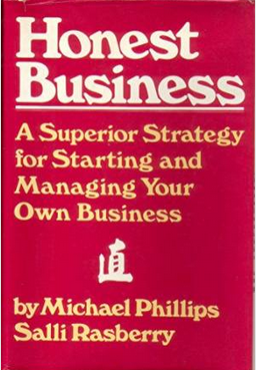About Briarpatch
In this page you’ll find:
- What is Briarpatch?
- Good sources of information about Briarpatch
- Doing Business the Briarpatch Way
- Historical Support and Benefits
- Briarpatch Volunteers
(founder, coordinators, apprentices, consulting team) - What you can do next
- Briarpatch contribution to society, culture, and history
- The Briarpatch History of Histories

What is Briarpatch?
Briarpatch is a network of friends in business aspiring to right livelihood and simple living. Its members practice local self-reliance and mutual support for small, really small, and one-person creative projects, cause-driven initiatives, or money-making enterprises.

Whether a creative project, cause-driven initiative, or money-making enterprise, Briarpatch sees them all as “businesses.”
Being in Briarpatch starts with the idea that you are a Briar if you:
- Aspire to right livelihood and simple living.
- Seek to make a good living doing work that you love.
- Are passionate about learning and have an insatiable curiosity about how the world works.
- See failure and mistakes as essential learning tools.
- Prefer cooperation to “going it alone.”
- Practice open books with your own tribe and community.
- Place a high value on personal and social responsibility.
- Put customer and stakeholder relationships ahead of just making money.
- Understand that profit or at least a positive cash flow is necessary to stay in business.
- Want to have fun in everything you do.
From 1974 through 2024, the Briarpatch saw more than 1,000 people pass through its membership roles. There have always been 200 to 300 names on the current mailing list with 100 to 200 active members at any given time. An active member is defined as anyone who pays dues or takes advantage of any member benefits on a regular basis. Such benefits include:
- parties
- classes and workshops
- monthly lunch meetings
- consulting team sessions
- member-driven good-works projects such as:
- The Apprentice Alliance (a matching service)
- Common Good School (for community organizing)
- Oak Study Group (to study group process)
- Noren Institute (a business school)
- or other community activities.
In the late 1970s and early 1980s, active members exceeded 400 in any given year, peaking at about 600 in the late 1980s.
- Hold a panel or lecture by one or more Briarpatch celebrities and 100 people attend.
- Throw a party and 50 or more people show up.
- Hold a workshop on business skills and up to 30 or more members participate.
Good Sources of Information About Briarpatch
The best sources of information about the Briarpatch are the stories we tell about our experiences across the last four-plus decades.
As you will see, if you explore this website, there are many Briars who love sharing their stories, usually by way of the printed word.
To get you started, here are brief descriptions of four books that serve as chronicles of our first two decades.
1978—The Briarpatch Book edited by Michael Phillips, Salli Rasberry, and other members.
We published a periodic “journal” from 1974 through 1978 entitled the Briarpatch Review. The Briarpatch Book is a compilation of the first 8 issues.
Each issue included community and business stories alongside articles about the lessons we learned between the publication of Seven Laws in 1974 and 1978, when The Briarpatch Book was published.
Still widely available online and in used bookstores.

Nine Principles of Right Livelihood Business
The following three books unfold, explain, and illustrate 9 important principles we have confirmed are essential for success in any “right livelihood” business.
These are:
- 1) Passion for one’s work.
- 2) Honesty and openness.
- 3) Financial records and statements.
- 4) Tradeskill.
- 5) Openness (again).
- 6) Capital.
- 7) Measurement.
- 8) Listings.
- 9) Generosity.
In the descriptions of the next three books, you’ll find a short definition of the three principles emphasized in each book.
1974—The Seven Laws of Money by Michael Phillips and Salli Rasberry with Stewart Brand, Dick Raymond, and Jug ‘n’ Candle.
Michael and Salli wrote this book in response to a growing interest in business and money during the early 1970s by friends and friends of friends who had been social activists in the 1960s. Salli was writing Rasberry Exercises about parent-sponsored schools and people were asking her how to raise money to pay for these. She asked Michael for some advice and Seven Laws was born.

Based on an ancient algorithm, the Seven Laws of Money are the context within which the nine “first principles” for Briar-type businesses are practiced. As delineated in the book these laws are:
- Law 1. Do it! The money will come when you are doing the right thing.
- Law 2. Money has its own rules: records, budgets, savings, and borrowing.
- Law 3. Money is a dream – a fantasy as alluring as the Pied Piper.
- Law 4. Money is a nightmare – in jail, robbery, fears of poverty.
- Law 5. You can never really give money away.
- Law 6. You can never really receive money as a gift.
- Law 7. There are worlds without money.
Yes, Seven Laws can be seen as a book about personal finance, but, more importantly, it is a definitive introduction to three key principles or practices that are critical to success in a right livelihood business:
Principle 1. Passion for one’s work. Feeling passionate about one’s work supplies self-starting energy, persistence, and deeply personal meaning which act in concert as a feedback loop refreshing and renewing one’s passion.
Principle 2. Honesty and openness. When launching adventures that depend on cooperation and a community of support, honesty and openness become superior strategies.
Principle 3. Financial records and statements. Accurate accounting records and regularly reviewed detailed financial statements are key to making any project, initiative, or enterprise work. (This is the practical application of the Second Law of Money.)
Briars Dick Raymond, Jug ‘n’ Candle, and Stewart Brand contributed to the book.
The version published in 1974 is the complete, original one. Look for the black and white cover with the image of a solar eclipse. The “Shambhala Pocket Edition” is an abbreviated version.
1981—Honest Business: A Superior Strategy for Starting and Managing Your Own Business by Michael Phillips and Salli Rasberry
A more detailed explanation of an emerging Briarpatch business strategy derived from the lessons learned by Briar members since the 1974 publication of Seven Laws.
In Honest Business, Phillips and Rasberry clarified three more Briarpatch principles or practices:

Principle 4. Tradeskill. Running a successful business requires unique attitudes and skills favoring business success that you usually learn as a child exposed to a well-run business. Salli, Michael, and other Briars called these “tradeskill.”
Principle 5. Openness (again). Openness in business has community, customer, and managerial advantages
Principle 6. Capital. Capital is not central to business success. There are almost always alternatives to capital, such as gifted or loaned equipment, rent-free space, or consignment of inventory. Too much capital can be even worse than not enough.
1986-2008—Marketing Without Advertising (6 Editions) by Michael Phillips and Salli Rasberry.
First edition subtitle: Inspire Customers to Rave About Your Business to Inspire Lasting Success
Second through sixth edition subtitle: Easy Ways to Build a Business Your Customers Will Love & Recommend
This book is a marketing handbook for any business hip to the power of relationships and the questionable efficacy of interruption advertising. Includes a case against interruption-type advertising (billboards, political signs, advertising posters, display ads, radio and TV ads).

Based on source material gathered during delivery of a Noren Institute course by the same name (Noren was a Briarpatch business school). There are six editions out there; any of them are great. Avoid the Kindle Version of the Sixth Edition.
Another three principles are central to the content of this book:
Principle 7. Measurement. The only way to know what’s going on is to measure. Always meter your ads.
Principle 8. Listings. Listing ads (directories, for example) are superior to interruption ads (billboards, TV, for example). Metering will tell you whether this is true for your business.
Principle 9. Generosity. “Generous” marketing, such as freeware, shareware, generous licensing fees, generous affiliate programs, or warranties that go the extra mile will garner a larger market share than advertising.
1989, 1994—Running a One-Person Business: Business as Lifestyle by Claude Whitmyer and Salli Rasberry (with Michael Phillips). (1989, first edition; 1994, second edition)
This book is the overall handbook for starting the unique one-person business form. Most of what we share in this book also applies to small businesses with employees. However, in this book, we include an emphasis on staying a one-person business as a foundation for lifestyle freedom (somewhat akin to the messages of later books such as The $100 Startup or The Four-Hour Workweek).

TABLE OF CONTENTS
- Foreword by Tom Peters
- Introduction: Business as Lifestyle
- Chapter 1. One-Person Business Owners—A Unique Group
- Tradeskill
- Market Focus
- Profiles of Successful One-Person Businesses
- Resources
- Chapter 2. Bookkeeping
- Business—A Set of Measurable Exchanges
- Bookkeeping Basics—Money In, Money Out
- Inventory
- Financial Statements
- Do You Need a Tax Accountant?
- Resources
- Chapter 3. Financial Management and Control
- Understanding Cash Flow
- Business and Financial Planning
- Your Business Plan
- Understanding Working Capital
- Types of Financing
- Resources
- Chapter 4. Financial Strategies
- Strategies for Controlling Expenses
- Strategies for Increasing Income
- Pricing Products and Services
- Credit and Collections
- Customer Service
- Physical Layout
- Resources
- Chapter 5. Information Management
- What is Information?
- Telephone
- Daily Records
- Files
- Information Overload
- Resources
- Chapter 6. Time Management
- Why Manage Time?
- Vision, Purpose, and Goals
- Objectives, Action Steps, and Daily Tasks
- Time Planning
- Billable and Nonbillable Time
- Office Hours
- Meetings
- Resources
- Chapter 7. Setting Up Shop
- The Choice—To Work at Home or Away from Home
- Office at Home, with Family—Special Considerations
- Office Layout
- Rules for Organizing Your Space
- Furniture and Fixtures
- Resources
- Chapter 8. Choosing Office Equipment—High Tech or Low?
- Evaluating Technology—Features versus Cost
- On the Lookout for Technology for Your Busines
- Questions to Ask About Any Technology
- How Much of My Income Should I spend on New Technology
- Resources
- Chapter 9. Grassroots Marketing
- The Case Against Advertising
- Personal Recommendation—The Heart of Grassroots Marketing
- Creating a Marketing Plan
- Publicity
- Marketing Checklist
- Resources
- Chapter 10. Emotional Support Systems
- Stabilization Through Routine
- Overcoming Isolation
- Having Fun
- Getting and Giving Support
- The Importance of Trust in Making Support Work
- Giving Back More Than You Get
- Handling Emergency Emotional Needs
- Taking Time Off
- Active Health Practices
- Concerns About Old Age
- Chapter 11. Staying a One-Person Business
- The Need for Backup
- The Perils of Managing Others
- The Importance of Good Suppliers
- The Value of Client Contracts
- How to Stay Current in Your Field
- Resources
- Appendix: Start-Up and Legal Matters
- Business Start-Up Basics
- The Legal Form of Your Business
- Resources
- Index
Note: Running a One-Person Business was published before the laws were passed that made the Internet accessible to the public. So you won’t find anything specific to the Internet. That said, 90% of the advice shared is still as valid today as it was when first published in 1989 and 1994 (second edition). Even the generic advice about choosing technology still works while the technology being chosen is far more advanced than anything we had back then. A lot of what we recommended was considered radical and much of it has now become mainstream. Many of today’s “secrets of Internet business” or “secrets of success for the ‘solopreneur'” are the same common-sense practices we found worked best for the small, really small, or one-person business, regardless of calendar era.
The Briarpatch Bookshelf
The five books just listed are a great start. Visit The Briarpatch Bookshelf for more about any of these and info about additional books to study when you’re ready.
Historical Support and Member Benefits
- Monthly meetings: Networking, brainstorming, mutual support for doing right livelihood businesses.
- Available online since March 2017. Contact us to get an email invitation.
- Consultations: Clinics and technical assistance from volunteers who are experts in their own fields.
- Previously available face-to-face.
- Now available over Zoom.
- Visit the Briarpatch Consultations page for instructions on how to set up your own appointment.
- Networking: Cooperative discussions and support from other Briarpatch members.
- —Currently available through:
- Monthly Meetings
- Briarpatch Network on Ning
- Briarpatch Network on Facebook
- —Currently available through:
- Member referrals.
- Referrals within the network for resources, tips, and tools, as well as opportunities to patronize fellow members for products or services.
- Community
- Occasional parties
- Classes, workshops, & seminars
- Special events, summits, conferences.
- Directory of members
- Newsletter.
Most of these benefits are “members only” but some are open to the public.
-
- Either way, contact us to be added to the notifications list.
Briarpatch Volunteers
What You Can Do Next
If you made it this far, then you’re likely feeling an affinity for the Briarpatch. What can you do next?
First, look within, just to make sure we’re right in our assumptions about your feelings or interest.
Are any of these you?
- You think “greed is good” and/or “making money” is your primary driving force.
- You’re hoping to sell something to network members.
- You think we’re a bunch of loud-mouthed hippies that don’t know what we are talking about.
You think "greed is good" and/or "making money" is your primary driving force.
If so, we have nothing to offer that will help you. At the root of our successful business strategies lie “right livelihood” and “simple living.”
“Right livelihood” means we aspire to deeply meaningful work that does no harm to others.
“Simple living” means we aspire to reduce our negative impacts by consuming less and applying smart cost-saving measures to our businesses and projects. Because they cost less to run, we need less income to live on.
The reduced purchasing power of less income equates directly to a lowered environmental impact.
Simple living is also about the fresh aesthetic that appears as a result of simplifying your living space by having less stuff.
Having less stuff means less futzing around with, repairing, and maintaining your stuff.
So simple living is also about reclaiming time for the meaningful things in life like creative pursuits, friendships, and community building.
You're hoping to sell something to network members.
If you’re thinking about joining to get access to the email list you should know selling to members through direct mail or email campaigns has never worked.
- We feel compelled to point out that in the past 5 plus decades of our existence, many have attempted this. None have succeeded.
- It seems that receiving unsolicited messages from strangers trying to sell something we haven’t asked about just doesn’t work with our members. Apparently, that’s not how we do business.
- We’ve always been truthful about it, warning every hopeful seller who has identified themselves.
- We’ve lost track of the amount of time and money wasted on the many attempts.
You think we're a bunch of loud-mouth hippies that don't know what we're talking about.
Then let’s just part company on friendly terms.
- Feel free to send any other loud mouth hippies you run across in our direction.
Okay. Enough of that! Back to "What You Can Do Next"
There are many options. While it might be wisest to keep it simple and suggest only one action to take, we can’t do that without learning more about who you are and what you are seeking.
So, if you’re a relative stranger, here are the action steps we think make the most sense. You can choose from among them. Or, maybe you’ll get a brainstorm and come up with something “outta the box!” If so, please share.
Option 1. Purchase one or more of the books we listed at the top of this page.
They are still widely available on Amazon, eBay, or at Bookfinder.com. Between the five of them, they give a good sense of the first few years of our existence and are filled with inspirational stories about small, really small, and one-person businesses, creative projects, and causes.
Option 2. Visit Our History Pages
If you can’t wait to learn more about our past, visit the “History of Histories” on this site and start reading now.
Option 3: Check Out Our Right Livelihood Handbooks
If you’re less interested in how we came to be and looking for more about the nuts and bolts of the success strategies we use, we have two books to recommend. They are each based on the knowledge we gathered from our experiences within Briarpatch. We further refined that knowledge by offering a learning-expedition type course** for each topic during the several years that we ran our alternative business school, Noren Institute. The courses each had the same title as the matching book:
** Def. learning expedition – We loaded students into a bus and visited member businesses that exemplified the principles of the specific course we were teaching. For example, for Running a One-Person Business, we visited one-person businesses such as small-business consultant Paul Terry of Paul Terry and Associates and Jim Lewis, the developer of the “Astro*Carto*Graphy Map.” (or “astrocartography” – applying astrology to your choice of where to live).
At the end of the day, we would adjourn to our meeting room to process that day’s experiences. We learned a lot from each site visit as well as from the “students” who themselves were building their one-person businesses.”